When planning a wedding, selecting the perfect flowers is essential to setting the tone and ambiance of the event. The Nerine flower, also known as the Guernsey Lily or Jersey Lily, stands out as an exquisite choice for couples seeking elegance and vibrancy. With its funnel-shaped blossoms available in striking shades of white, red-orange, pink, and crimson, Nerine adds a sophisticated touch to any arrangement. Additionally, their long stems and impressive vase life make them not only visually stunning but also practical. What makes Nerine particularly unique for wedding decor? Let's explore further.
Flower Overview
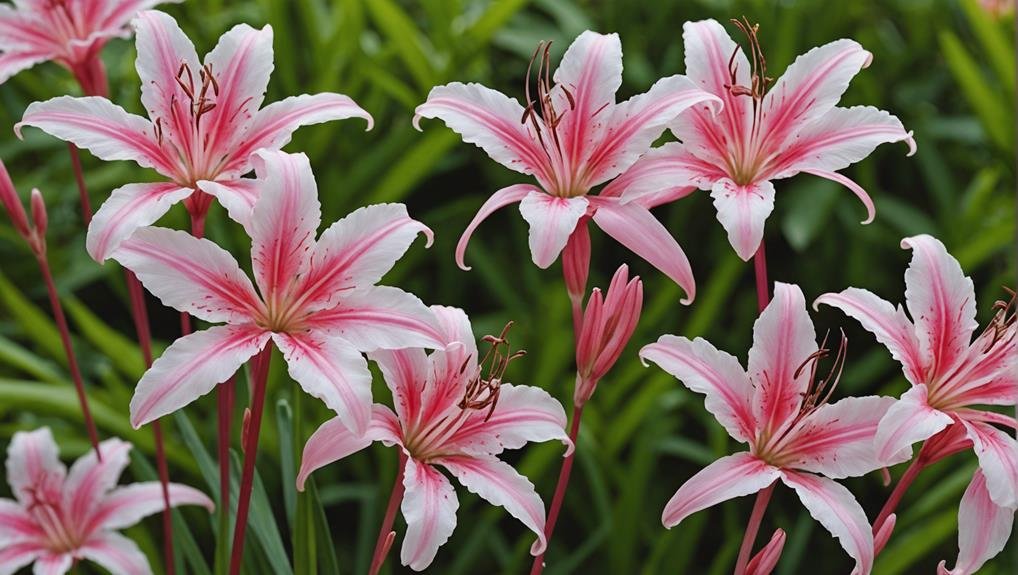
Nerine, commonly known as Guernsey Lily or Jersey Lily, is a striking flower native to South Africa that stands out for its vibrant hues and seasonal bloom. Renowned for their radiant colors, Nerine flowers add a touch of elegance and vibrancy to any floral arrangement.
These flowers are particularly popular in wedding bouquets due to their diverse color palette, which includes shades of white, red-orange, pink, and crimson. This variety allows for versatile pairing with other exotic flowers, such as parrot tulips, to create visually stunning displays.
Typically blooming from late summer to autumn, Nerine flowers are a favored choice for weddings during these seasons. Their extended vase life of 10-14 days makes them ideal for ornamental displays and guarantees that wedding arrangements remain fresh and vibrant throughout the event.
When purchasing Nerine flowers, it is recommended to select partially open buds and store them at temperatures between 2-4°C to preserve their freshness.
Physical Description
Characterized by delicate, funnel-shaped blossoms perched atop long, leafless stems, the Nerine flower captures attention with its vibrant hues and elegant form. Often used in wedding flowers, Nerine blooms add a refined touch to floral arrangements. These blossoms range in size from 1 to 2 inches, making them a perfect choice for adding a graceful flourish to any bouquet or centerpiece.
The long, leafless stems of Nerine flowers range from 16 to 26 inches, lending themselves well to tall floral designs often seen in wedding decor. This height allows for dramatic, eye-catching displays that can enhance the overall aesthetic of the event. Additionally, the Nerine's vase life of 10 to 14 days guarantees that the beauty of these flowers endures throughout the festivities, providing lasting elegance.
Nerine flowers are particularly favored for wedding arrangements due to their striking appearance and durability. Here are three reasons why they evoke a sense of charm and sophistication:
- Elegant and Delicate Blossoms: Their unique, graceful shape makes them stand out.
- Long-lasting Beauty: A vase life of up to two weeks ensures extended enjoyment.
- Versatile Stem Length: Ideal for creating varied and dynamic floral displays.
Available Colour Varieties
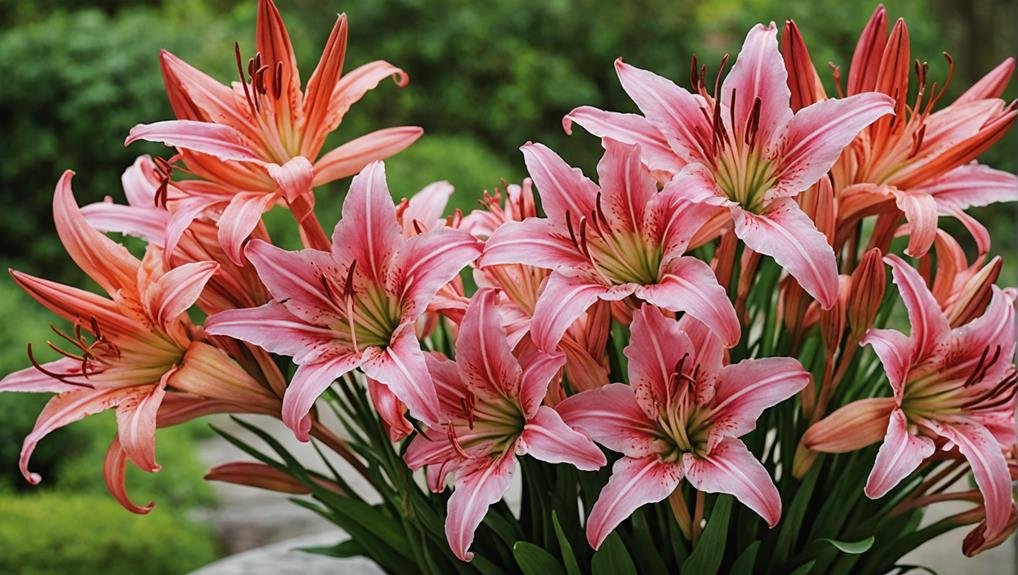
Among the vibrant colour varieties available, white, red-orange, pink, and crimson stand out for their ability to enhance any wedding floral arrangement. These hues offer a remarkable range of options for creating eye-catching floral arrangements and complementing diverse colour palettes. The versatility of these colours makes nerine flowers a popular choice in event planning, as they can seamlessly blend into various thematic settings.
The symbolism of nerine flowers adds another layer to their appeal. White nerines, for example, often represent purity and elegance, making them a classic choice for traditional wedding bouquets. The red-orange and crimson varieties bring a sense of passion and energy, ideal for couples looking to make a bold statement. Pink nerines, with their softer, romantic appeal, are perfect for creating a dreamy, whimsical atmosphere.
Seasonal trends also influence the popularity of nerine flowers. In Australia, these blooms are particularly sought after in late summer and autumn. Thanks to commercial cultivation and imports, nerines are available year-round, ensuring they can be incorporated into bouquet designs whenever needed. For best freshness, it is recommended to choose partially open buds with coloured petals that are not yet fully open.
Latin Name and Taxonomy
Understanding the botanical background of nerine flowers provides deeper insight into their unique characteristics and horticultural significance. Nerine, commonly known as Guernsey Lily or Jersey Lily, belongs to the Amaryllidaceae family. The Latin name for these captivating flowers is Nerine spp., a term that signifies the diverse species within this genus. Named after the Nereids, sea nymphs in Greek mythology, nerine flowers are celebrated for their elegance and grace.
- Taxonomic classification and Morphological features: Nerine's taxonomic classification situates it within the Amaryllidaceae family, distinguished by its bulbous nature and striking, vibrant inflorescences. The flowers display a variety of morphological features, from slender, strap-like leaves to umbels of star-shaped blooms in shades of white, red-orange, pink, and crimson.
- Evolutionary history and Genetic diversity: Originating from South Africa, nerine flowers have evolved to exhibit significant genetic diversity. This diversity contributes to their adaptability and the broad spectrum of colors and forms available.
- Breeding programs and Conservation efforts: Current breeding programs aim to enhance the ornamental value and resilience of nerine flowers, while conservation efforts focus on preserving their genetic diversity and natural habitats, ensuring their sustainability for future generations.
Geographical Origins
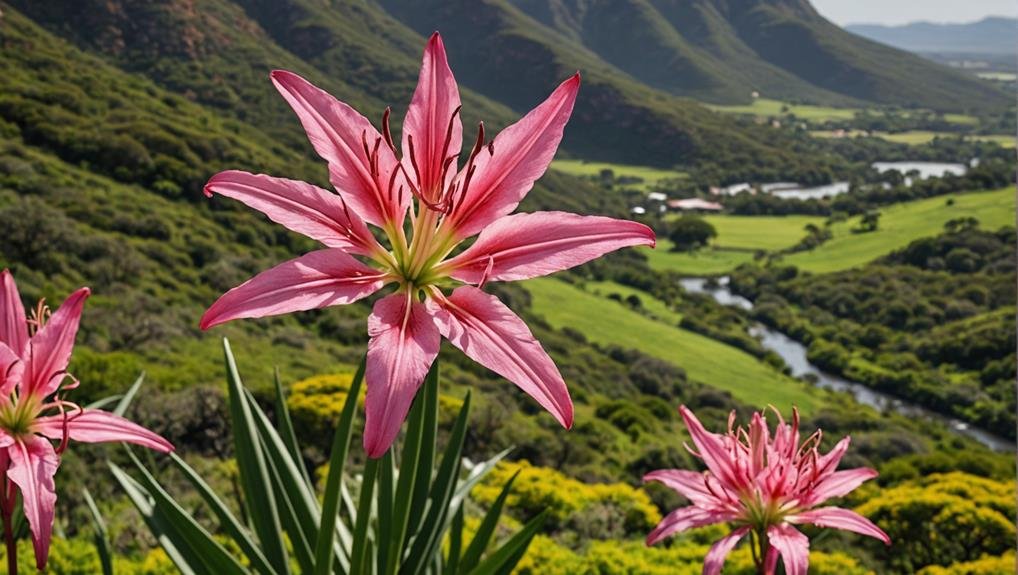
Nerine flowers, with their vibrant hues and striking forms, originate primarily from the diverse and ecologically rich regions of South Africa. These regions' unique climate requirements contribute significantly to the successful cultivation of Nerines. South Africa's varied climate zones, from coastal Mediterranean to more arid inland areas, provide an ideal environment for these resilient blooms. Nerines thrive in well-drained soils under full sunlight, reflecting their natural adaptation to the sunny and sometimes drought-prone conditions of their homeland.
The natural habitats of Nerine flowers encompass rocky outcrops and grasslands, where they grow in clusters, often adding splashes of color to the landscape. These habitats are characterized by a combination of adequate moisture during their growing season and a dry period, which is essential for their dormancy. This cyclical climate pattern supports their blooming cycle, resulting in the spectacular display that makes them so popular in floral arrangements.
In South African culture, Nerines hold indigenous symbolism, often associated with beauty and resilience. This symbolism is rooted in their ability to flourish in challenging environments, making them a fitting choice for weddings, where they can represent enduring love and strength. Their origins and cultural significance add a rich, meaningful layer to their aesthetic appeal.
Season Availability
As we admire the rich cultural heritage and geographical origins of Nerine flowers, it is equally important to take into account their seasonal availability for wedding planning. Nerine flowers bloom from late summer to autumn, making them an ideal choice for weddings during this period. Their vibrant hues can add bright splashes of color to any floral arrangement or bouquet.
Here are three key points to keep in mind:
- Optimal Bloom Timing: Nerines are at their peak from late summer through autumn. This makes them perfect for seasonal wedding decor, allowing brides and grooms to make the most of their natural beauty during these months.
- Sourcing Options: While nerine flowers are commercially cultivated in Australia, they can also be imported when out of season. This guarantees that even off-season weddings can feature these stunning flowers in DIY arrangements or bouquet ideas.
- Preservation Tips: To maintain the freshness of nerine flowers, select those with partially open flowers and colored, yet unopened buds. Utilize flower food, store them at 2-4°C, remove dried sheaths, and keep them well-hydrated. These nerine care tips will help preserve their beauty for your big day.
Growing Conditions
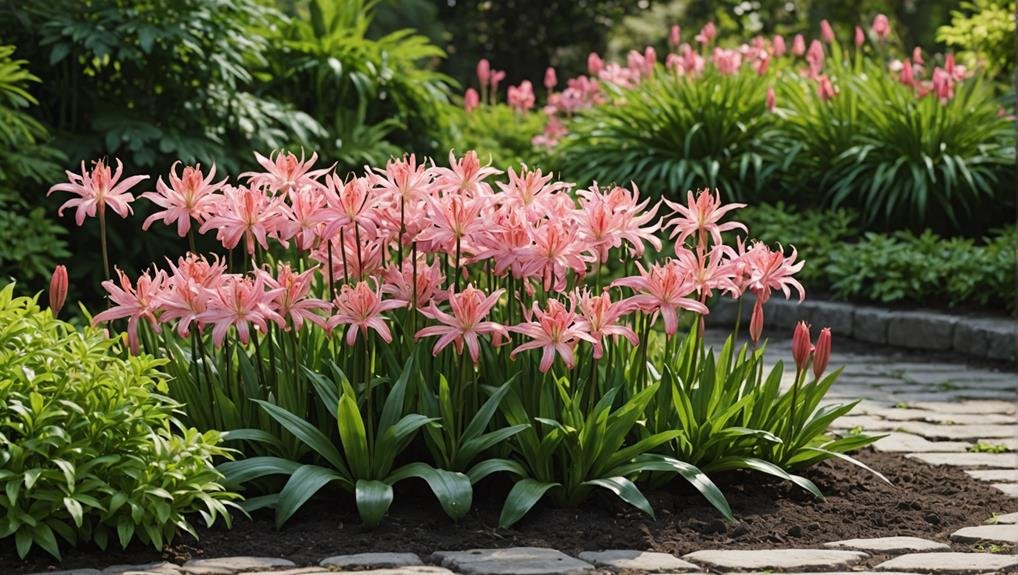
To maximize growth, nerine flowers need well-draining soil and full sun exposure. Making sure that the soil meets these requirements is essential for their development. The soil should be light, sandy, and able to drain water efficiently to prevent root rot.
Full sunlight is necessary for promoting strong growth and vibrant blooms, so choose a planting location that receives ample sunlight throughout the day.
When it comes to watering frequency, nerines need moderate watering. It's important to allow the soil to dry out between waterings, as overly moist conditions can lead to bulb rot. During the growing season, water the plants thoroughly but infrequently to maintain ideal moisture levels.
In colder climates, frost protection is vital for nerines. Bulbs are vulnerable to frost damage, so mulching or covering them during colder months can provide necessary insulation. Alternatively, bulbs can be lifted and stored indoors until the threat of frost has passed.
Regular division of nerine bulbs every few years is recommended to promote healthy growth and prevent overcrowding. This division schedule not only rejuvenates the plant but also encourages more abundant blooming in subsequent seasons.
Cultural Significance
Often celebrated for their delicate beauty and vibrant hues, nerine flowers hold a deep cultural significance across various societies. Known for their symbolic meaning, these flowers are often associated with femininity and grace. The vibrant colors of nerine flowers symbolize passion, love, and creativity, making them an ideal choice for various cultural rituals and celebrations.
The historical connections of nerine flowers can be traced back to Greek mythology, where they are linked to the Nereids, sea nymphs renowned for their beauty and charm. This mythological association has cemented nerine as a symbol of elegance and sophistication throughout history. Additionally, in some cultures, these flowers are believed to bring good luck and prosperity, particularly in weddings and special events.
In summary, the cultural significance of nerine flowers can be highlighted by their roles in various traditions and beliefs:
- Symbolic Meaning: Representing femininity, grace, passion, love, and creativity.
- Historical Connections: Linked to the Nereids in Greek mythology, symbolizing beauty and charm.
- Cultural Rituals: Used in floral arrangements to convey elegance and thought to bring good luck in weddings and special events.
Understanding these aspects can enrich one's appreciation of nerine flowers beyond their aesthetic appeal.
Typical Use in Weddings
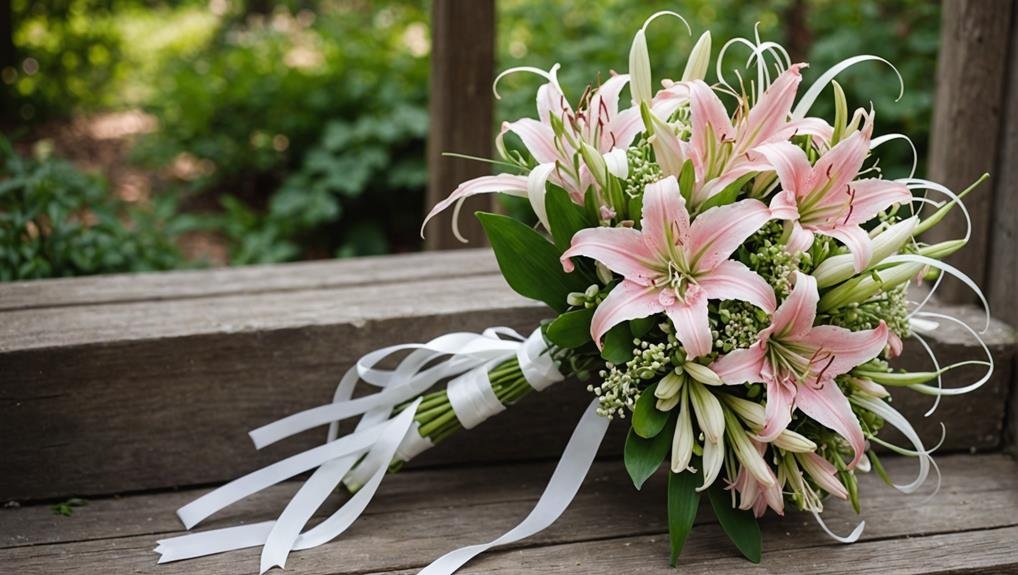
Nerine flowers are frequently chosen for wedding bouquets and arrangements due to their elegant appearance and vibrant color options. Their long stems and delicate blooms make them particularly suitable for a wide array of wedding floral designs. Available year-round, nerine flowers offer versatility, allowing for consistent and cohesive floral arrangements across different seasons. Their popularity peaks in late summer and autumn weddings, where their bright colors add a striking touch to the decor.
In bridal bouquets, nerine flowers serve as a focal point, lending an air of sophistication and vibrancy. They are also commonly used in table centerpieces, where their height and striking appearance can draw attention and enhance the overall aesthetic of the reception. For ceremony decorations, nerines can be arranged in tall vases or integrated into archways and altar arrangements, creating a visually appealing backdrop for the vows.
Additionally, reception arrangements benefit from nerine flowers due to their long vase life, ensuring that the décor remains fresh throughout the celebration. Boutonnieres and corsages featuring nerine blooms provide a cohesive floral theme, tying together the bridal party's attire and the overall wedding aesthetic.
| Use | Description | Benefit |
|---|---|---|
| Bridal Bouquets | Focal point in the bride's bouquet | Elegance and vibrancy |
| Table Centerpieces | Enhances aesthetic at reception tables | Height and striking appearance |
| Ceremony Decorations | Integrated into vases or archways | Visually appealing backdrop |
| Reception Arrangements | Long-lasting floral displays | Freshness throughout the celebration |
| Boutonnieres & Corsages | Cohesive floral theme | Complements bridal party attire |
Alternative Flower Types
While nerine flowers offer a striking option for wedding floral arrangements, several alternative flower types can also provide unique aesthetic benefits and complement various wedding themes. These alternatives can be used to create unique arrangements, serve as bouquet alternatives, and open up various decorative possibilities.
- Roses: Known for their timeless elegance, roses are a versatile choice for any wedding. Available in a wide range of colors, they can easily match any color scheme and theme. Roses can be used in bouquets, centerpieces, and even as aisle decorations, offering endless creative possibilities.
- Peonies: Celebrated for their lush, full blooms, peonies add a touch of romance and sophistication to any wedding. Their delicate petals and pleasant fragrance make them a popular choice for bridal bouquets and table arrangements, especially in spring and early summer weddings.
- Tulips: With their sleek shape and vibrant hues, tulips bring a modern touch to wedding floral designs. They are ideal for minimalist and contemporary wedding themes, offering a fresh and clean look. Tulips can be used in mixed arrangements or stand-alone bouquets to create a striking visual impact.
These alternative flower types provide a range of options for creating beautiful and personalized wedding floral arrangements.
